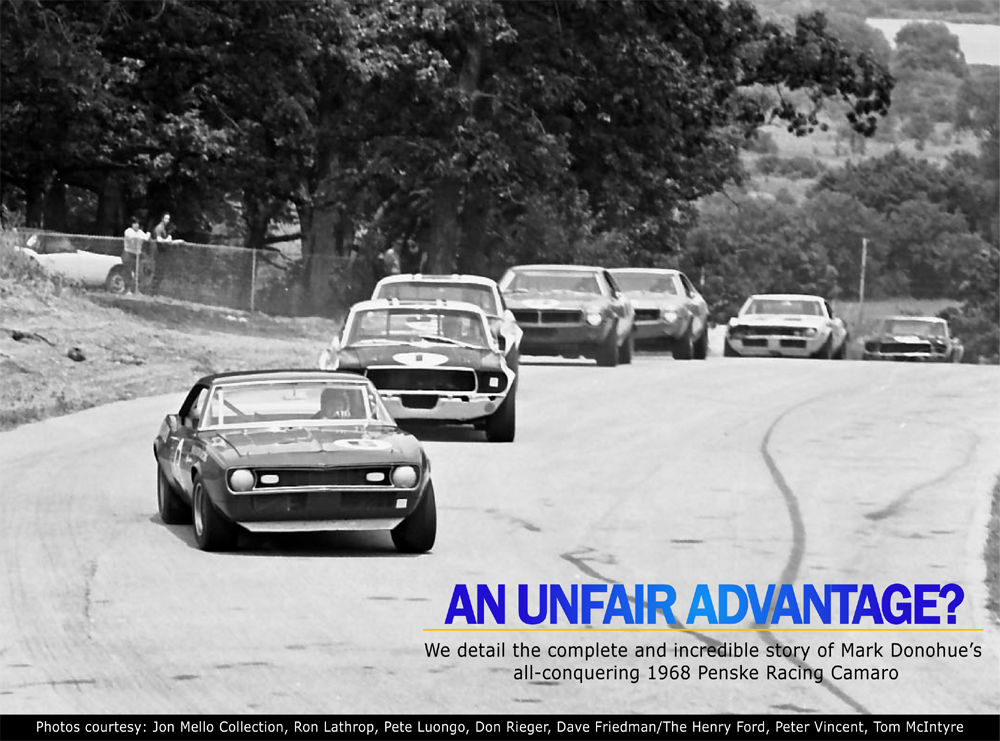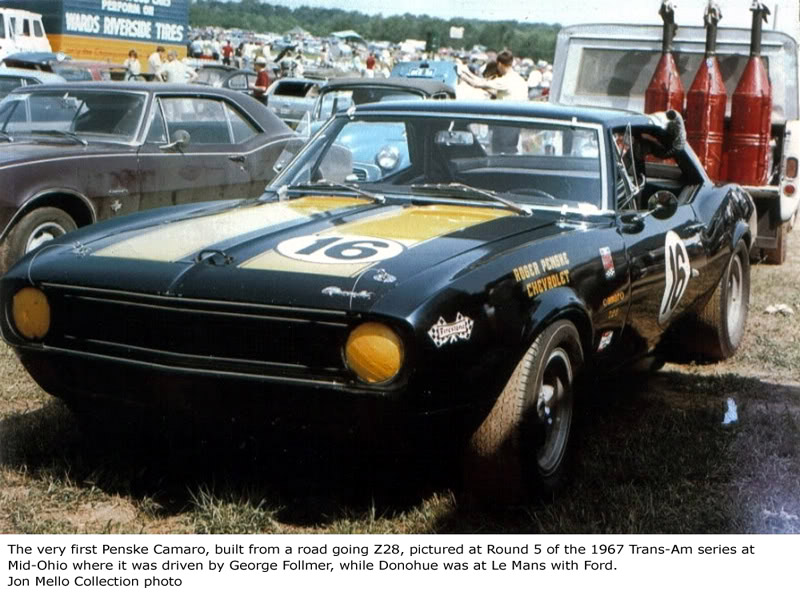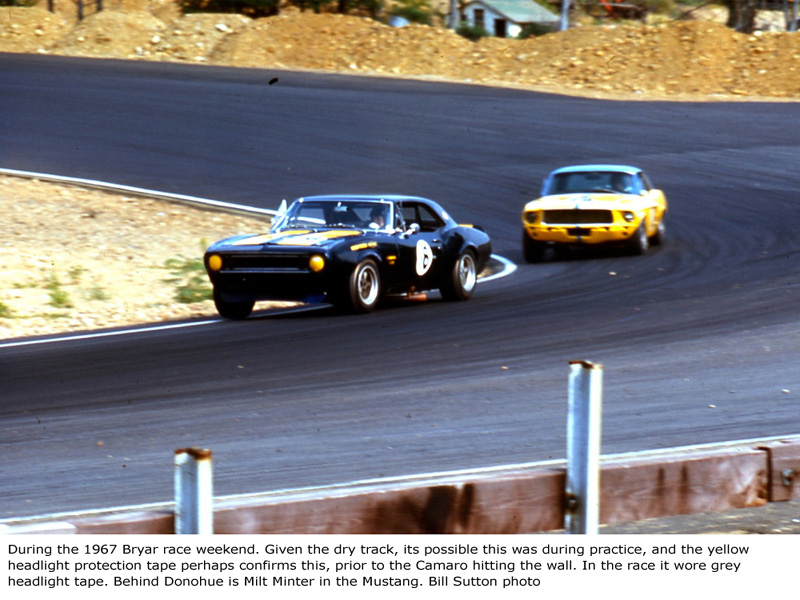-
Administrator

Article: An Unfair Advantage?

“I had only been working full-time in Roger Penske’s shops for a short while when he asked if I’d be interested in putting together a Trans-Am Camaro”, explains Mark Donohue in his book The Unfair Advantage.
Penske and Donohue first met in 1959, but it wasn’t until mid-1966 the pair finally teamed up. Donohue was a mechanical engineer, studying at Brown University in Providence, Rhode Island. His engineering background drove a natural desire to constantly tinker and improve on the standard fare throughout his motor racing career, venturing further with each new project.
Working his way through the usual myriad of late 1950s/early ‘60s British and American production sports cars and junior single seaters, he won the Sports Car Club of America E/Production Championship in 1961, driving an Elva Courier he’d purchased the year prior. By 1965, he was racing a Shelby GT 350R, owned by Malcolm Starr, sponsor of a Lotus 20 he’d raced in Formula C. With this car he won the SCCA B/Production Northeast Division Championship, gaining him an invitation to contest the American Road Race of Champions run-offs at Daytona. Here he led for much of the race, comfortably outgunning the factory Shelby GT 350R of Jerry Titus until the outside rear tire burst due to the compressed loads of the Daytona banking pressing the bodywork onto the rubber.

For 1966 he picked up a factory ride in endurance sports car racing with Ford’s GT MkII program, running at selected events including Daytona, Sebring, and Le Mans. He and Roger Penske got to talking while at the funeral of close friend, Walt Hansgen, in April 1966. Penske asked Donohue if he’d like to drive his Lola T70 spyder in USRRC and Can-Am events, and Donohue agreed. Penske paid him $50 per day, for each day he worked. At this stage, Donohue held down a full time 9-5 day job. Motor racing was still a weekend hobby for him, despite the intensity with which he attacked it, even then.
The Lola was a battle from the get-go. Given Eric Broadley of Lola Cars was primarily in the business of selling race cars, the exact same T70 chassis could be bought by anyone. So, the Penske guys figured they’d gazump the competition through brute horsepower, and fit the Lola with a big block Chevy, when most others were running small blocks. But, it wasn’t a success. After struggling for much of the year, and wrecking a couple of cars, the team switched to a small block like everyone else. But Donohue had begun questioning his future as a race car driver, and was about ready to call time on his brief career at the end of the season, until Roger Penske convinced him otherwise. He offered Mark a full time position, and rewarded him financially for his efforts. So the Camaro Trans-Am was the first Penske project Donohue had a hand in from the outset.
The SCCA created the Trans-American Sedan Championship in 1966. To be eligible, no less than 1,000 models must have been produced in the last twelve months. The rules were based on those of FIA Groups 1 and 2, although in the Trans-Am they were referred to as A/Sedan and B/Sedan. Classes were then broken up based on engine size: 0 – 2,000cc, and 2,001 – 5,000cc (this later became 0 – 2,500cc and 2,501 – 5,000cc). Maximum wheelbase was 116 inches. Eventually, an 8 inch wheel width limit would be established for the Over-2 cars, as well as a minimum racing weight of 2,800 pounds (1,270 kilograms). As the Trans-Am grew, so interest (both spectator and manufacturer) centred upon the bellowing V8 pony cars as they surfed their boom period of the late ‘60s.

“Roger has always liked to go to the endurance races at Daytona and Sebring. Now, here it was January (1967) and he didn’t have a car to enter”, Donohue explained. A brand new, road going factory red Z28 Camaro was bought, and delivered to the Penske workshop, where Donohue and fellow Penske team member Bill ‘Murph’ Mayberry tore into it. “I had a rough idea what to do with the car to prepare it for racing. In those days there were certain simple basics: install a roll bar, strip the upholstery, fit big tires, and so on. In the meantime, Traco was putting together a 302-inch version of the 333 small block we had been running in the Lola”.
Jim Travers and Frank Coon (Traco was a play on their surnames, TRAvers and COon) built stout power plants, and the team knew they’d have good horsepower, so could focus on race preparing the rest of the car. Given Donohue’s success developing and racing the Shelby GT 350R, Roger Penske assumed his new steed would quickly knock together a world beater, but the new Camaro presented its own challenges, and Donohue found himself swinging in the dark.
“Roger was in touch with the engineers at Chevrolet, and they kept asking him what (suspension) spring rates we were going to use. Then Roger would ask me. But I didn’t want to answer… because I really had no idea. When he saw that I was unsure, he became unsure that I knew what I was doing”. Eventually, Donohue took a punt on 1,200 pound springs in the front, and 400 pound springs in the rear. The car sat very low, virtually on its bump-stops, and also employed the factory Z28 rear axle radius rod. It wore 15” American Racing 5-spoke wheels, wrapped in Firestone rubber. They squirted it in dark blue Sunoco paint (in reference to the teams main sponsor) with yellow stripes, and took it to Bridgehampton for a quick test, where all its ugly traits were revealed.
 Posting Permissions
Posting Permissions
- You may not post new threads
- You may not post replies
- You may not post attachments
- You may not edit your posts
-
Forum Rules






 Reply With Quote
Reply With Quote